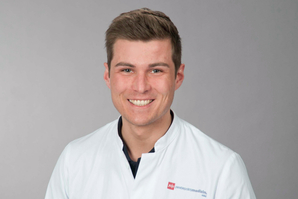Michael Molitor
The role of PAR-2 signalling in cardiac ageing and inflammation in heart failure

Ageing is a major risk factor for cardiovascular diseases, reflecting the most important cause of morbidity and mortality worldwide. Intrinsic cardiac ageing is a slow, progressive structural and functional decline of the heart with increasing age, which is insufficiently covered by current therapies. It is characterised by chronic low-grade inflammation, termed “inflammaging”, combined with important hallmarks of ageing, especially cellular senescence, mitochondrial dysfunction and epigenetic alterations, leading to left-ventricular hypertrophy and vascular dysfunction. Deciphering the mechanism of ageing in heart failure and especially the role of Protease-activated Receptor 2 (PAR-2) signalling will be in the focus of this project.
Positions held
- Since 2024: Clinician Scientist funded by CHANCE, Department of Cardiology, University Medical Center (UMC) and Institute of Molecular Biology (IMB), Mainz
- Since 2021: Speaker of Young-DZHK, Partner site Rhine-Main
- 2018 - 2022: Speaker/Representative of Cardiology Residents, University Medical Center Mainz
- 2018 - 2020: Virchow Fellowship, Center for Thrombosis and Hemostasis (CTH), University Medical Center Mainz
Since 2017: Clinician Scientist, Department of Cardiology, University Medical Center Mainz
Education
- 2020 - 2022: Master of Health Business Administration, Friedrich-Alexander University Erlangen
- 2015 - 2016: Medical Studies (final year), Memorial Sloan Kettering Cancer Center New York and Gemeinschaftsklinikum Mittelrhein Koblenz
- 2010 - 2015: Medical Studies, Johannes Gutenberg University (JGU) Mainz
Selected publications by Michael Molitor
Molitor M, Rudi WS, Garlapati VS, Finger S, Schüler R, Kossmann S, Lagrange J, Nguyen TS, Wild J, Knopp T, Karbach SH, Knorr M, Ruf W, Münzel T and Wenzel P (2021) Nox2+ myeloid cells drive vascular inflammation and endothelial dysfunction in heart failure after myocardial infarction via angiotensin II receptor type 1.Cardiovasc Res, 117(1):162-177 Link
Neulen A*, Molitor M*, Kosterhon M, Pantel T, Holzbach E, Rudi WS, Karbach SH, Wenzel P, Ringel F and Thal SC (2021) Correlation of cardiac function and cerebral perfusion in a murine model of subarachnoid hemorrhage. Sci Rep, 11(1):3317 (*indicates joint contribution) Link
Efentakis P*, Molitor M*, Kossmann S, Bochenek ML, Wild J, Lagrange J, Finger S, Jung R, Karbach S, Schäfer K, Schulz A, Wild P, Münzel T and Wenzel P (2021) Tubulin-folding cofactor E deficiency promotes vascular dysfunction by increased endoplasmic reticulum stress. Eur Heart J, 43(6):488-500 (*indicates joint contribution) Link
Molitor M*, Jimenez MTB*, Hahad O, Witzler C, Finger S, Garlapati VS, Rajlic S, Knopp T, Bieler T, Aluia M, Wild J, Lagrange J, Blessing R, Rapp S, Schulz A, Kleinert H, Karbach S, Steven S, Ruf W, Wild P, Daiber A, Münzel T and Wenzel P (2023) Aircraft noise exposure induces pro-inflammatory vascular conditioning and amplifies vascular dysfunction and impairment of cardiac function after myocardial infarction.Cardiovasc Res, 119(6):1416–1426 (*indicates joint contribution) Link
